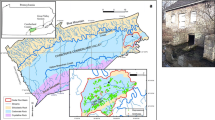Abstract
A radon monitoring system capable of continuous real-time monitoring of well gas radon was devised and tested in a climate change observation network. It comprised a radon detector and could help observe the groundwater in a well, blocking the inflow of outside air. The water temperature, electrical conductivity, and water level were also monitored in the groundwater well. The temperature and electrical conductivity were almost constant within a 1% error range in both the 5-day preliminary and the 7-month long-term tests. The groundwater level appeared to be related to radon concentration, and tidal forces may have influenced both radon concentration and groundwater levels.







Similar content being viewed by others
References
U.S. Environmental Protection Agency, (2012) A Citizen’s Guide to Radon: the Guide to Protecting Yourself and Your Family from Radon. Environmental Protection Agency, U.S
World health Organization (WHO) (2009) Handbook on indoor radon: A public health perspective. WHO, Geneva
Cicerone RD, Ebel JE, Britton J (2009) A systematic compilation of earthquake precursors. Tectonophysics 476:371–396. https://doi.org/10.1016/j.tecto.2009.06.008
Igarashi G, Saeki S, Takahata N, Sumikawa K, Tasaka S, Sasaki Y, Takahashi M, Sano Y (1995) Ground-water radon anomaly before the Kobe earthquake in Japan. Science 269:60–61. https://doi.org/10.1126/science.269.5220.60
King CY (1981) Do radon anomalies predict earthquakes? Nature 293:262–262. https://doi.org/10.1038/293262a0
Kuo MCT, Fan K, Kuochen H, Chen W (2006) A mechanism for anomalous decline in radon precursory to an earthquake. Ground Water 44:642–647. https://doi.org/10.1111/j.1745-6584.2006.00219.x
Laiolo M, Cigolini C, Coppola D, Piscopo D (2012) Developments in real–time radon monitoring at Stromboli volcano. J Environ Radioact 105:21–29. https://doi.org/10.1016/j.jenvrad.2011.10.006
Silver PG, Wakita H (1996) A search for earthquake precursors. Science 273:77. https://doi.org/10.1126/science.273.5271.77
Cigolini C, Poggi P, Ripepe M, Laiolo M, Ciamberlini C, Delle Donne D, Ulivieri G, Coppola D, Lacanna G, Marchetti E, Piscopo D, Genco R (2009) Radon surveys and real–time monitoring at Stromboli volcano: Influence of soil temperature, atmospheric pressure and tidal forces on 222Rn degassing. J Volcanol Geotherm Res 184:381–388. https://doi.org/10.1016/j.jvolgeores.2009.04.019
Shouchuan Z, Zheming S, Guangcai W, Rui Y, Zuochen Z (2020) Groundwater radon precursor anomalies identification by decision tree method. Appl Geochem 121:104696
Corbett DR, Burnett WC, Cable PH, Clark SB (1997) Radon tracing of groundwater input into par pond, savannah river site. J Hydrol 203:209–227. https://doi.org/10.1016/S0022-1694(97)00103-0
Schmidt A, Schlueter M, Melles M, Schubert M (2008) Continuous and discrete on–site detection of 222radon in ground– and surface waters by means of an extraction module. Appl Radiat Isot 66:1939–1944. https://doi.org/10.1016/j.apradiso.2008.05.005
Santos IR, Niencheski F, Burnett WC, Peterson R, Chanton J, Andrade CFF, Milani IB, Schmidt A, Knoeller K (2008) Tracing anthropogenically driven groundwater discharge into a coastal lagoon from southern Brazil. J Hydrol 353:275–293. https://doi.org/10.1016/j.jhydrol.2008.02.010
Sukanya S, Noble J, Joseph S (2021) Factors controlling the distribution of radon (222Rn) in groundwater of a tropical mountainous river basin in southwest India. Chemosphere 263:128096. https://doi.org/10.1016/j.chemosphere.2020.128096
Zmazek B (2010) Identification of radon anomalies in soil gas using decision trees and neural networks. Nukleonika 55:501–505
Reddy DV, Nagabhushanam P (2011) Groundwater electrical conductivity and soil radon gas monitoring for earthquake precursory studies in Koyna, India. Appl Geochem 26:731–737. https://doi.org/10.1016/j.apgeochem.2011.01.031
Tsunomori F, Tanaka H (2014) Anomalous change of groundwater radon concentration monitored at Nakaizu well in 2011. Radiat Meas 60:35–41. https://doi.org/10.1016/j.radmeas.2013.11.006
Tsunomori F, Kuo T (2010) A mechanism for radon decline prior to the IzuOshima–Kinkai Earthquake Japan. Radiat Meas 45(1978):139–142
Wakita H, Nakamura Y, Notsu K, Noguchi M, Asada T (1980) Radon anomaly: A possible precursor of the 1978 Izu–Oshima–Kinkai earthquake. Science 207:882–883. https://doi.org/10.1126/science.207.4433.882
Cannelli V, Piersanti A, Galli G, Melini D (2018) Italian radon monitoring network (IRPN): a permanent network for near real-time monitoring of soil radon emission in Italy. Annals Geophysics 61(4): SE444. https://doi.org/10.4401/ag-7604
Althoyaib SS, El–Taher A, (2015) Natural radioactivity measurements in groundwater from Al-Jawa, Saudi Arabia. J Radioanal Nucl Chem 304:547–552
Pinault JL, Baubron JC (1997) Signal processing of diurnal and semidiurnal variations in radon and atmospheric pressure: a new tool for accurate in situ measurement of soil gas velocity, pressure gradient, and tortuosity. J Geophys Res 102:18101–18120. https://doi.org/10.1029/97JB00971
Barberio M, Gori F, Barbieri M, Billi A, Devoti R, Doglioni C, Petitta M, Riguzzi F, Rusi S (2018) Diurnal and semidiurnal cyclicity of radon (222Rn) in groundwater, Giardino Spring, Central Apennines, Italy. Water 10:1276. https://doi.org/10.3390/w10091276
Mentes G, Eper-Pápai I (2015) Investigation of temperature and barometric pressure variation effects on radon concentration in the Sopronbánfalva Geodynamic Observatory, Hungary. J Environ Radioact 149:64–72. https://doi.org/10.1016/j.jenvrad.2015.07.015
Crockett RGM, Gillmore GK, Phillips PS, Denman AR, Groves-Kirkby CJ (2006) Tidal synchronicity of built–environment radon levels in the UK. Geophys Res Lett 33:L05308. https://doi.org/10.1029/2005GL024950
Barnet I, Prochzka J, Skalsk L, (1997) Do the earth tides have an influence on short–term variations in radon concentration? Radiat Prot Dosim 69:51–60. https://doi.org/10.1093/oxfordjournals.rpd.a031887
Durridge Co Inc. (2018a) RAD7-electronic radon detector-user manual. https://durridge.Com/documentation/RAD7
Acknowledgements
This work was supported by the Basic Research Project (20-3411) of the Korea Institute of Geoscience and Mineral Resources (KIGAM), funded by the Ministry of Science and ICT.
Author information
Authors and Affiliations
Corresponding author
Additional information
Publisher's Note
Springer Nature remains neutral with regard to jurisdictional claims in published maps and institutional affiliations.
Rights and permissions
About this article
Cite this article
Lee, K., Ha, K., Lee, SH. et al. A continuous radon monitoring system for integration into the climate change observation network. J Radioanal Nucl Chem 330, 547–554 (2021). https://doi.org/10.1007/s10967-021-07894-7
Received:
Accepted:
Published:
Issue Date:
DOI: https://doi.org/10.1007/s10967-021-07894-7




